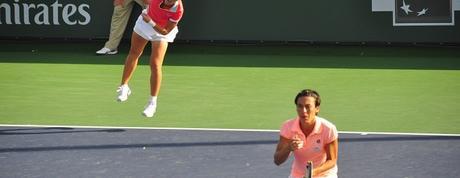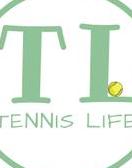
Have you ever played a doubles tennis match in which either you or your partner are consistently losing your service games, even if you're both serving well? When that happens, do you tend to play it safe and/or pray to the tennis gods that you will eventually win your serve?
And... how is that working for you?
Believe me, I know that frustration, but with these strategies, you can help break that cycle and win more matches:
Poach
One strategy is poaching, or volleying the opponent's return. You want to try and place your serve down the middle, or "T" of the service box. When receiving a serve down the "T", the returner doesn't have much of an angle to go for a passing shot down the line, and will more than likely return up the middle, so your partner at the net should be ready to take a step or two toward the middle of the court while moving in diagonally to volley the return. A good volley target is at the feet of the returner's partner, which will more than likely result in a winner or a pop up which then can easily be put away.
I-Formation
Mess with your opponent's mental game by changing up the look of the court with the I-formation. When serving, stand close to the center mark as if serving for a singles game, and have your partner straddle the center line in the service boxes and get down low, bending at the knee as well as at the hip. (This forces the returner to guess which direction the player at net will move.) Make sure you communicate with your partner before you serve so you'll know in which direction they'll be moving afterward. A good scenario is to aim the serve at the T or at the receiver's body to limit the return angles. Once you serve the ball, move to the opposite side of the court from where your partner at the net has moved. In the I-formation, the goal is for the server's partner at the net to play offensively and volley the return.
Australian
If the return team has consistent, strong cross court returns, the Australian formation is a great strategy to use, especially when serving from the ad side and to the returner's backhand. This is similar to the I-formation, only the server doesn't stand as close to the center marker, and the player at the net stands in the service box on the same side as the server. This will force your opponent to return with their backhand down the line, or risk their return being picked off at the net. ** NOTE: This is not a good option if your opponent has a killer backhand.
Both back on the baseline
The last strategy a serving team should try is for the server and the server's partner to both play back at the baseline. I know what you're thinking." The goal in doubles is to control the net, so WHY would we both stand back at the baseline... on purpose?!" Well, if you're having trouble holding serve against a team who consistently rips the ball right at the net player, then this is a good strategy to try as it a) takes away their "sitting duck", and b) allows you to throw up offensive, deep lobs over their net player. This will force your opponents to stay back and hit defensively, giving you and your partner an opportunity to move in to the net and take care of business.
Next time you find that you or your partner are having trouble holding serve, go ahead and test out these strategies. Changing up the look of the court and playing more aggressively and keeping your opponents on the defense will help change the momentum so your team can win more matches!


